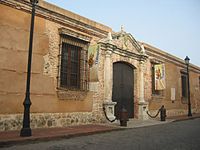- Museo de las Casas Reales
-
Coordinates: 18°28′33″N 69°53′00″W / 18.475883°N 69.883208°W
Museum of the Royal Houses Museo de las Casas Reales 
Facade of the Museo de las Casas Reales in the Colonial district of Santo DomingoEstablished 1976 Location Santo Domingo,
 Dominican Republic
Dominican RepublicType Historical and Cultural Director Ana Yee de Cury[1] Website cultura.gov.do The Museo de las Casas Reales, is one of the important cultural monuments built during the colonial era in la Hispanola. This monument is located in the Colonial district, of Santo Domingo in the Dominican Republic.
According to historians, this structure dates back to the sixteenth century, and it was built to house the administrative offices of the Spanish colonies in the Americas. The building was divided into two floors. On the first floor was the Royal Court, which was the first podium of the New World, and on the second floor, was the Captaincy General.
Contents
History
The Museum of the Royal Houses or Royal Palaces, as it was called during the colonial era, was to host two palaces, which date back to the sixteenth century. The royal palace was built by orders of the Spanish Crown, represented by King Fernando de Aragon on October 5 of 1511, which was built to house the main government offices of the era.
This building was named as the Royal Houses, as it was the Royal Court, which was the first court of the New World, was also used as the residence of the Governors and General Captains of the time.
The building served as home to many major figures such as; Nicolas de Ovando, Bartholomew Columbus, and Louis Ferrand, among others. The halls of the Royal Court held important meetings or parties involving the leading figures in society of the colonial era as well as royal officers and judges of appeal. Also involved, were Bishops of the Conception such as Don Pedro Suarez de Deza and other Franciscan, Dominican and Mercedarian representatives.
The Royal Court formally exercised jurisdiction over La Hispaniola and all neighboring islands and territories discovered by or belonging to the Spanish Crown. The Royal House at Santo Domingo was the capital of all other Spanish territories in the New World until 1535, after the Aztec Conquest opened new lands and the belief that local rule rather than centralized rule was better. After 1835 and the establishment of the Viceroyalty of New Spain, as well as other Viceroyalties, the Royal Court in Santo Domingo adopted a more local role as the Capital of the West Indies. Yet the Royal House, although stripped of its title as the Capitol of the New World, was involved in many major issues such as; the Rebellion of Enriquillo, the Indian Rebellion of Cuzco, the differences between Alvarado and Almagro, territorial problems in Central America, Venezuela, Florida and Louisiana, to mention a few.
Throughout its history the original architectural structure has undergone many changes. In 1807 the French general Louis Ferrand gave the facade a French-style. During the last year of government of President Carlos Felipe Morales, some changes were made to use the building as the Governmental Palace. Then during the government of Rafael Leónidas Trujillo other modifications were made in order to house some government offices.
Museo de las Casas Reales today
The Museum of the Royal Houses is a historical monument because it showcases colonial architecture. On October 18, 1973, during the administration of President Dr. Joaquín Balaguer, the building was established as a museum, but it was not officially opened until May 31, 1976. Attending the opening ceremony was King Juan Carlos I of Spain.
This museum was established to collect and to highlight the history, life and customs of the inhabitants of the Spanish colony. It is currently one of the most visited sights by tourists in Santo Domingo, because it is located in the Zona Colonial.
The museum has 9 rooms in 2 interconnected buildings; the first was the Palace of the Governors and the other was the Royal Court and Office of the Comptroller General.
Location
This cultural museum is located on Calle Las Damas, corner of Calle Las Mercedes, in the Colonial Zone of Santo Domingo, Dominican Republic.
Halls of the Museum
The museum is divided into two floors and several rooms respectivamentes, which are:
First floor
Here are the following salons, which are divided into galleries of topics.
- Lobby
- Gallery
- Patio
- Backyard
- Health
- Cafeteria
- Temporary Exhibition Hall
- Ladder
- Statue of A. Suazo
Galleries issues or statements of these rooms are:
- Discovery, conquest and evangelization.
- Smuggling and piracy
- Economy.
- Stables.
- Santa Bárbara.
- Drugstore.
- Transport and garage.
Second floor
Here are the following salons:
- Gallery of Hearing.
- Gallery.
- Halls Arms
- Ladder.
In the galleries or exhibition themes are:
- Numismática and Accounts.
- Legislation.
- Secretaries of hearings.
- Office of the Chief hearers.
- Hall Waiting.
- Chamber Main hearers.
- Ante Dispatch Captains.
- Descpacho Captain General.
- Family Life.
- Historical Ceramología.
- Military I.
- Military II.
- Great Hall of Governors.
Architectural features
This is of great interest because it has a strong character and there is high interest in its history, it also holds assets of cultural interest associated with its architecture that form an integral part of the values that the institution has to offer to its visitors.
This building was built during the colonial era, based on masonry and fine stones, with an Elizabethan/Gothic-style mixed with Plateresque Renaissance and a quasi-military appearance.
See also
- Dominican Republic
- Santo Domingo
- History of the Dominican Republic
- Zona Colonial
References
- ^ "Museo de las Casas Reales" (in Spanish). cultura.gov.do. http://www.cultura.gov.do/dependencias/museos/museodelascasasreales.htm. Retrieved 29 April 2011.
External links
Categories:- Museums in the Dominican Republic
Wikimedia Foundation. 2010.
